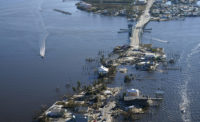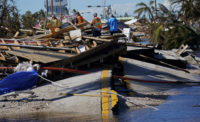The Central Florida Expressway Authority envisions a future where a truck may be able to travel back and forth from the Gulf to the Atlantic or from the Panhandle to the Keys, without stopping to plug in or fill up on gas. Toward that, CFX is launching a $13.6-million pilot project, as part of a new highway, to advance dynamic-wireless vehicle charging technology and test its scalability.
On the pilot, the authority is partnering with ASPIRE, an electrified-transportation research center based in Utah, and has chosen green technology firm ENRX as the in-motion wireless supplier.
“Our DNA is innovation, that’s just who we are,” says Michelle Maikisch, executive director of CFX, which is funding the effort she describes as "the beginning" of a conversation on what this technology could do at the national level.
Through the pilot, CFX hopes to identify ways to bring the technology to scale and to move toward cost-effective solutions. The authority also intends to refine equipment standards and designs the to extend electric vehicle range, decrease cost of vehicles thanks to smaller batteries made feasible by in-road charging, increase the load capacity for freight transport via smaller batteries and improve the opportunities in autonomous freight, rideshare and deliveries.
Maikisch and Sean Parks, Lake County commissioner and a CFX board member, say feedback has been positive and there’s been plenty of interest locally and beyond, including from state legislators in Tallahassee, on the project. Groundbreaking is planned for April 4.
Of the 2.4-million fully electric vehicles registered throughout the U.S. at the end of 2022, Florida accounted for just under 168,000, second only to California, according to the U.S. Dept. of Energy.
The ASPIRE Engineering Research Center at Utah State University—the acronym stands for Advancing Sustainability through Powered Infrastructure for Roadway Electrification—will install the approximately one mile of dynamic wireless induction charging on the new Lake/Orange Expressway, using ENRX’s inductive technology. Another will be placed at ASPIRE's test track in Utah.
ENRX will install a 200kW dynamic charging system allowing electric vehicles to charge their batteries while driving, the company explains. Once installed, the system is maintenance free.
ENRX says it’s the only company with dynamic charging experience in powers above 100 kW. Typical fast charging is less than 150 kW, with everything above that mark qualifying as rapid charging.
Under the system, electric vehicles receive a charge as they drive over electric coils embedded in the roadway. The coils flow power to a receiver pad mounted under the vehicle.
Toll-funded CFX, which oversees expressways in Brevard, Lake, Orange, Osceola and Seminole counties, is including the pilot project in the first segment of the three-segment, $650-million State Road 516 Lake/Orange Expressway to connect US 27 and SR 429 in Orange and Lake Counties.
The new 4.4-mile road will be CFX’s most sustainable ever, including a wildlife tunnel and a multiuse trail alongside the electrified roadway, according to CFX. Construction is set to start late this year, with completion dates still pending for two of the three portions. The 0.9-mile segment three is scheduled to be done in early 2027.
In December, the CFX Governing Board approved a $219-million construction contract for the segment including the electrified roadway portion to SEMA.
The electrified roadway will be constructed with precast concrete panels about 3 ft wide x 11 ft long, housing the charging technology and set longitudinally along the outside lane, with traditional concrete cast on top, says Glenn Pressimone, chief of infrastructure at CFX.
“So the road surface is just going to look like a concrete pavement,” he says.
The panels will be placed along roughly three-quarters of a mile of the new roadway, between two bridges in the first segment, still in final design. The pavement design has been fatigue-tested by a 13-ton single-axle wheel driving over it more than 1.25 million times, according to CFX, which through the pilot project will do real-world field testing to further improve the design.
Florida, with its triple-digit temperatures that can drop quickly in a storm and stress concrete, provides a unique environment for the pilot as well, Pressimone says. Pair that with a greenfield project allowing integration from the start and a limited-access, high-speed roadway and the SR 516 project becomes a particular fit for the experiment.
"The technology is proven," he explains. This pilot is more about refining installation and seeing how the system stands up to Florida's heat.
And the idea isn’t to drive across this road to get a vehicle to a full charge, Pressimone says, but to essentially cover the energy expended to make the drive.
“It brings enough charge so that … wherever you get on the facility, you’ll have the same charge when you get off the facility,” he adds.
Arrays like the one planned for SR 516 could be placed every few miles along a portion of highway to charge electric vehicles as they travel, eliminating the need for stops. Pair that with future advances in autonomous vehicles and the picture of driverless, never-stopping trucks crossing the country begins to come into view.
“I think that’s the vision,” Pressimone says. “This isn’t going to happen tomorrow," but autonomous vehicles and in-road charging are going to work together toward moving freight smarter and more efficiently, he adds.
Cost remains an obstacle to the technology reaching that scale.
“If we can find the means and methods to get a form liner that works, then all you need to do is buy the form liner and that makes it similar to any other piece of precast concrete that’s out there,” Pressimone says.
The form liner used in the pilot will be sent to Utah, where ASPIRE’s test track is, and researchers will reach out to local concrete firms to see what they can make of it.
“Part of the whole test is it has to be scalable to the real world, and everything can’t be custom,” he says. “The pilot can be custom, but after that it’s got to be something you can just order. That’s what we want.”
Once that’s achieved, essentially anyone who does concrete work should be able to make the panels, bringing the cost down, he says, which is all part of the goal of the pilot.





Post a comment to this article
Report Abusive Comment